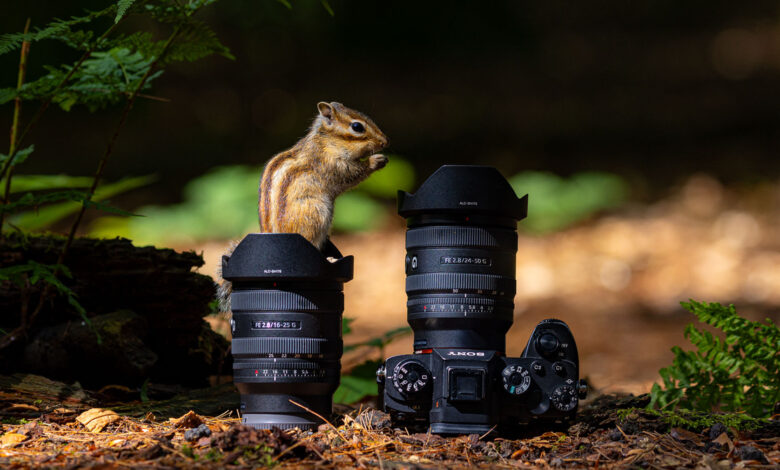My review of the Sony FE 16-25mm and FE 24-50mm f/2.8 G

There are two Sony lenses that are both interesting and intriguing. The FE 16-25mm f/2.8 G and FE 24-50mm f/2.8 G are small, lightweight f/2.8 lenses with limited zoom range. How do they perform and are they worth buying? Let’s find out.
The idea is great: introduce two lightweight zoom lenses with f/2.8 aperture across the entire zoom range. These lenses will be easy to carry, inconspicuous, and user-friendly. However, there is a catch. The focal range will be limited.
The FE 16-25mm f/2.8G Lens does not reach 35mm, like similar lenses in this range. The FE 24-50mm f/2.8G lens miss at least 20mm at the longer end of the zoom range. At first, this doesn’t seem like a problem. However, using these lenses for extended periods of time makes me wish I had more focal length often.
Appearance
Despite the difference in zoom range, the two lenses look identical. You have to look at the text on the lens to know which is which. They both have programmable aperture rings and lens buttons. There is a zoom ring and a focus ring that is just a little wider.
One of two switches on the lens allows you to switch between manual and autofocus. The other switch turns off the clicking sound of the aperture ring. There’s no built-in stabilizer, so you have to rely on the camera’s own IBIS system.
When zoomed in, the lens changes length. The barrel of the FE 24-50mm extend much further than FE 16-25mm. Other differences are minor and not noticeable unless you compare the specifications. In the list below, the first number is for the FE 16-25mm, the second number is for the FE 24-50mm.
- Dimensions: 74.8 x 91.4 mm / 74.8 x 92.3 mm
- Weight: 409 g / 440 g
- Minimum focusing distance (autofocus): 0.18 m (W) and 0.24 m (T) / 0.19 m (W) and 0.30 m (T)
- Minimum focusing distance (manual focus): 0.17 m (W) and 0.22 m (T) / 0.18 m (W) and 0.29 m (T)
- Magnification (autofocus): 0.2x / 0.3x
- Magnification (manual focus): 0.23x / 0.33x
Other specifications are the same for both lenses:
- 11 aperture blades (circular)
- Two linear AF motors can perform 120 calculations per second
- Dust and moisture resistant
- Fluoride coating resists fingerprints and repels water and oil
Image quality
Overall, the images produced by both lenses are good. They show good contrast and image sharpness. However, these lenses rely heavily on the in-camera lens correction function. Distortion compensation cannot be disabled and it is built into the raw file.
However, with Lightroom, raw images still have distortion and some vignetting. Since the lens profile is built into the raw file, there is no option to use a dedicated lens profile. This makes it difficult to remove all the remaining distortion and vignetting in post-production.
The importance of lens correction with these lenses will be clearly demonstrated by comparing the results, as illustrated below.
Chromatic aberrations can be seen with these lenses, but can be removed quite easily. Regarding flare, both the FE 16-25mm and FE 24-50mm perform well, providing good glare protection in most situations. Sometimes glare occurs, but it’s not too serious.
Depth of field and narrow bokeh
Both lenses have an f/2.8 aperture across the entire zoom range. This is perfect for low light situations. A wide aperture will also reduce depth of field. Since focal length is also responsible for shallow depth of field, these lenses won’t go into extremes.
You can get a reasonably narrow depth of field with the FE 24-50mm at 50mm, but any other focal length won’t blur the background much. I tested the bokeh of both lenses to see how the 11-blade circular aperture works.
Real World Use
As mentioned, wide apertures make these lenses suitable for low light conditions. However, don’t expect miracles from the f/2.8 aperture. In dark situations, you still need a high ISO value and you have to rely on the camera’s IBIS system or use a tripod.
The downside of these lenses is the limited zoom range. Not much for FE 16-25mmbut much more to FE 24-50mm. In many situations, I wish the lens would have a little more reach.
Of course, this is the price you pay for a light and compact lens. I have to say, I got used to the limited zoom range, which makes it a bit like shooting with a prime lens.
Autofocus is fast and quiet, aperture ring operates smoothly. The clicking sound is nice when taking pictures and I like the ability to turn the sound off. Lens button is a nice addition.
Lenses are not very effective against blurred backgrounds due to the focal length they provide. Of course, this also depends on your distance from the subject and the subject’s distance from the background. However, if there is any blurred background, it is usually not blurry enough.
My Conclusion on These Lenses
I love these lenses because they are small and light. They are easy to carry around and there is no reason not to carry both. However, the zoom range is so small that they are not versatile lenses, especially the FE 24-50mm. Sometimes it is annoying to be limited to that 50mm focal length.
Because of this limitation, you may want to carry a third lens with a longer focal length, thus reducing the benefits of a compact lens kit. On the other hand, the limited zoom range may force you to be more creative with your composition. But again, I think a prime lens is much better for that task.
The f/2.8 aperture doesn’t produce great blurred backgrounds at these zoom ranges. Wide apertures are best suited for low-light situations. Perhaps some portraits with 50mm and f/2.8 could produce a nice bokeh effect. However, I prefer an even wider aperture if I want a narrow depth of field.
After using these lenses for a while, I’m not sure if I like them or not. Both FE 16-25mm And FE 24-50mm are interesting lenses and I believe they have their own purpose. On the other hand, for me personally, the 16-35mm and 24-70mm zoom lenses, or even the 24-105mm, would be preferable, even if it is a bit heavier and the maximum aperture is f/4 .
What I like
- F/2.8 aperture across entire zoom range
- Overall image quality
- Size and weight
- Aperture ring
- Aperture click sound mute switch
- Fast autofocus
- Lens button
- Same lens diameter for filter
What I don’t like
- Limited zoom range
- Too dependent on the lens correction function in the camera
- Image Correction Profiles are not available on raw files in Lightroom Classic
- Narrow depth of field is not prominent due to zoom range
Exhibition room




